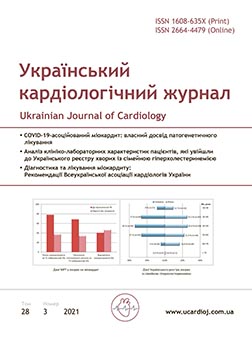General analysis of clinical and laboratory characteristics of the Ukrainian familial hypercholesterolemia registry
Main Article Content
Abstract
The aim – to evaluate clinical and laboratory characteristics of patients of the Ukrainian familial hypercholesterolemia registry taking into account gender differences.
Materials and methods. 231 patients with familial hypercholesterolemia were included to the Ukrainian Familial Hypercholesterolemia Registry: 8 children (under 18 years of age) and 223 adult patients (68 men (30.5 %), mean age 43.4±1.3 and 155 women) 69.5 %) – 45.5±1.0 years) with familial hypercholesterolemia verified according to the DLCN criteria. General clinical, laboratory, instrumental examinations and genetic testing were performed.
Results and discussion. In the general registry among the patients with familial hypercholesterolemia in the setting of early manifestation of atherosclerosis the male patients with familial hypercholesterolemia were more likely to have coronary artery disease, premature coronary artery disease, cerebral and peripheral atherosclerosis, xanthoma, hypertriglyceridemia, diabetes mellitus, smoking and a history of MI, which caused a higher DLCN score (9.3 points in men against 7.8 points in women, p<0.05). Female patients with familial hypercholesterolemia had a higher percentage of obesity and hypertension, which corresponds to the main gender trends of the Ukrainian population study.
Conclusions. Since 2017, for the first time in Ukraine, the register of patients with familial hypercholesterolemia has been initiated. In December 2019 the most severe form – homozygous familial hypercholesterolemia – was first included in the list of orphan diseases by the Order of the Ministry of Health of Ukraine. According to the analysis of the data of the Ukrainian familial hypercholesterolemia registry, this pathology is diagnosed rather late and insufficiently in Ukraine. In patients with familial hypercholesterolemia, against the background of an earlier manifestation of atherosclerotic lesions, gender features of the cardiovascular risk factors profile, which are characteristic of the entire adult population of Ukraine, are preserved. The lower severity of familial hypercholesterolemia clinical manifestations in women according to the general Ukrainian familial hypercholesterolemia registry may be due to the predominance of heterozygous forms in the registry and inclusion of women of reproductive age against the background of preserved antiatherogenic effects of estrogen to the registry.
Article Details
Keywords:
References
Митченко Е.И., Мамедов М.Н., Колесник Т.В., Деев А.Д. Современный профиль факторов риска сердечно-сосудистых заболеваний в городской популяции Украины // Укр. кардіол. журн.– 2013.– Додаток 4. Матеріали XIV Національного конгресу кардіологів України.– С. 76–83.
Мітченко О.І., Романов В.Ю., Чулаєвська Н.М., Тімохова К.О. Сімейна гіперхолестеринемія: етіопатогенез, діагностика, лікування та стан проблеми в Україні // Укр. кардіол. журн.– 2019. – № 4.– С. 23–31.
doi: 10.31928/1608-635X-2019.4.2331.
Doi T., Kataoka Y., Asaumi Y. et al. Sex-related differences in clinical characteristics, low-density lipoprotein cholesterol control and cardiovascular outcomes in familial hypercholesterolemia // Eur. Heart J.– 2017.– Vol. 38 (Suppl. 1).– P. 631. doi: 10.1093/eurheartj/ehx501.P631.
Mach F., Baigent C., Catapano A.L. et al. ESC Scientific Document Group, 2019 ESC/EAS Guidelines for the management of dyslipidaemias: lipid modification to reduce cardiovascular risk: The Task Force for the management of dyslipidaemias of the European Society of Cardiology (ESC) and European Atherosclerosis Society (EAS) // Eur. Heart J.– 2020.– Vol. 41 (1).– P. 111–188. doi: 10.1093/eurheartj/ehz455.
Nordestgaard B.G., Chapman M.J., Humphries S.E. et al. Familial hypercholesterolaemia is underdiagnosed and undertreated in the general population: guidance for clinicians to prevent coronary heart disease: Consensus Statement of the European Atherosclerosis Society // Eur. Heart J.– 2013.– Vol. 34 (Issue 45).– P. 3478–3490. doi: 10.1093/eurheartj/eht273.
Beheshti S.O., Madsen C.M., Varbo A. et al. Worldwide Prevalence of Familial Hypercholesterolemia. Meta-Analyses of 11 Million Subjects // J. Amer. Coll. Cardiololy.– 2020.– Vol. 75 (20).– P. 2553–2566.
Sharifi M., Syngal N., Jain A. et al. Gender Differences In Characteristics Of The Patients With Familial Hypercholesterolemia. Atherosclerosis. 287. 10.1016 // j.atherosclerosis.2019.06.660. doi: 10.1016/j.atherosclerosis.2019.06.660
Vallejo-Vaz A.J., Dharmayat K., Stevens C. et al. Characteristics of adults with heterozygous familial hypercholesterolaemia stratified by gender: Preliminary analysis from the EAS FHSC Global Registry on over 36,000 cases of familial hypercholesterolaemia. Abstract 1356 // Atherosclerosis.– 2020.– Vol. 315.– E13. doi: 10.1016/j.atherosclerosis.2020.10.052


